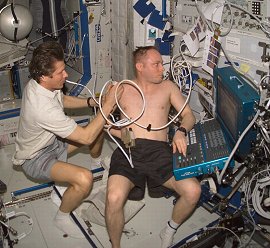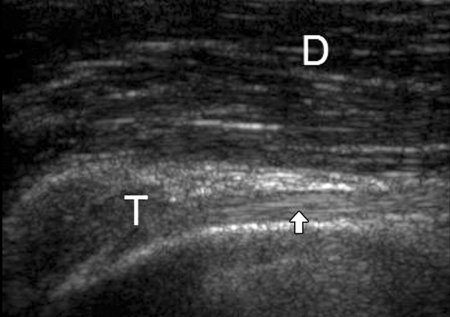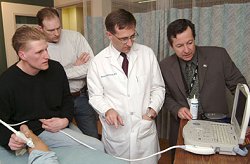|
Far away from doctors and hospitals,
astronauts in space are learning to give themselves checkups using
ultrasound.
by Karen Miller and Dr Tony
Phillips
When you hear the word
"ultrasound" you probably think of pregnant mums and their
babies. Add one more to that list: astronauts.
Nobody's pregnant in
space, but astronauts onboard the International Space Station (ISS)
are using ultrasound, looking inside themselves as part
of a NASA project called ADUM, short for "ADvanced Ultrasound
in Microgravity."
Dr. Scott Dulchavsky,
a surgeon at the Henry Ford Hospital in Detroit, heads the project.
His team, which includes co-investigators Doug Hamilton, Shannon
Melton and Ashot Sargsyan of Wyle Laboratories, in Houston, is studying
how ultrasound can be used to diagnose medical problems onboard
spaceships.
Here on Earth, doctors
can look at broken bones with an x-ray machine, they can look for
tumors with a CAT scanner, and they can examine your brain with
an MRI. None of those bulky instruments is available on any NASA
spacecraft.
There is, however,
an ultrasound machine onboard the ISS.

more
Onboard
the International Space Station, Gennady Palalka performs
an ultrasound exam on Mike Fincke.
|
Ultrasound offers several
advantages: Compared to other diagnostic imaging tools, ultrasound
machines are compact and lightweight. This is important on cramped
spaceships where every ounce of payload costs money to launch. Furthermore,
ultrasound images appear instantly. You don't have to wait for,
say, x-ray films to be developed. Got a problem? Ultrasound can
find it quickly.
An ultrasound probe
works somewhat like radar. It sends high-frequency (megahertz) sound
waves into the body. When those waves encounter an organ - say, the
liver - some bounce back immediately, and some continue, bouncing
back when they reach the next organ - say, the kidney. Because sound
waves travel through each organ, or tissue, at a different speed,
the probe is able to "see" what the reflected sound waves
have found.
Typically, ultrasound
has been used to look at internal organs. It's often used to examine
fetuses. But Dulchavsky and his team have been expanding its repertoire.
They're working out ways to look at eyes, teeth, lungs, bones and
muscles. They believe that ultrasound can be used for about two-thirds
of a list of approximately 500 medical conditions that might hypothetically
occur on a spacecraft.
And, in some cases,
ultrasound works even better in space than it does on Earth. That's
because in low gravity, internal organs move around. "The heart
shifts up. . . . The liver moves about three inches north."
The result is that organs often end up closer to each other. That's
good. Sound waves move from one to the other with less distortion,
providing a clearer ultrasound picture.

more
An
ultrasound view of ISS astronaut Mike Fincke's biceps
tendon. "D" denotes the deltoid muscle. "T"
is the proximal intracapsular end of the long biceps tendon.
|
Traditionally, ultrasound
probes are operated by technicians with several hundred hours of
training. Astronauts only get about four hours training. How do
they manage? "We're helping them," says Dulchavsky. As
the astronauts work the probe, they're in constant contact with
experts on the ground.
Recently, the procedure
was tested with ISS astronauts Mike Fincke and Gennady Padalka.
The ground crew and the astronauts relied on a satellite downlink
to share information. "[Mike] puts the probe to the skin, and
then, two seconds later we in the Johnson Space Center get to see
the same image he sees," says Dulchavsky.
It's an interactive
process: "We go, 'Mike, that's not quite right. Can you move
the probe an inch closer to the elbow?' So, Mike slides it down
an inch closer. 'Ah, that's really good, you need to push harder.'
Mike pushes harder. 'Almost perfect, move it half-an-inch to the
back. Ahh, you've got it. Perfect!'"
This technique, non-doctors
using ultrasound to obtain diagnostic quality pictures under the
guidance of remote experts, turns out to have important applications
on Earth - on battlefields, for instance, or in rural areas where
doctors are far away.
"We're looking
at modifying how we transmit the information, so we could do it
through a cellphone," says Dulchavsky. Picture this: "we
could put ultrasound probes on ambulances." Emergency room
doctors could set up a treatment before the patient even arrives
at the hospital.

more
Dr.
Scott Dulchavsky (far right) shows Detroit Red Wings trainer
Piet Van Zant (far left) how to use an ultrasound machine.
|
The process has already
been used successfully on the ground - in the locker room of the
Red Wings, Detroit's hockey team. "Players get hurt a lot in
NHL games," says Dulchavsky, a fan. "Last season, we trained
one of their trainers to use the probe. It worked famously."
It works well in space,
too. In the ISS experiment, Fincke and Padalka examined each others'
shoulders. That joint was picked, says Dulchavsky, because it's
so complicated. And, even though the shoulder is one of the most
challenging ultrasound examinations to do, the astronauts were able
to obtain clear, diagnostic-quality views.
A paper describing
the procedure was published in the February 2005 issue of the journal
Radiology; it's the first article ever submitted from orbit.
Right now, Dulchavsky
and his colleagues are analyzing their data. The next step, he says,
is to put together a program that will teach the astronauts to do
more and more on their own. This would enable ultrasound to be used
even on long-range exploration missions, like trips to Mars, where
guidance from the ground is less practical.
The ADUM project is
significant, says Dulchavsky, because it has pushed the limits of
what ultrasound technology can do. He and his colleagues plan to
push those boundaries even more.
|
